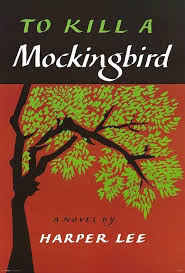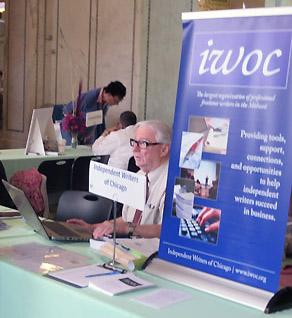 |
May 2015
Volume 34 Number 5 |
|
|
| IWOC: The Premier Resource for Professional Writers
|
|  | LinkedIn |
 |
Facebook |
|
 |
Twitter |
| IWOC WELCOMES
New Members
Marjorie Skelly
Douglas Tonks
& Returning Member
Michelle Acosta
|
| |
EDITOR'S INTRODUCTION
On the calendar, the vernal equinox occurs on March 20th when day and night are of equal length. That date is classified as the first day of Spring, but it would be a great leap of faith for anyone who lives in this area to believe that. Spring for us fairly reliably begins in May when we can shed our coats and boots and start thinking about planting and spring cleaning. Spring cleaning? You can turn the mattress and scrub the floors if you want to. I don’t care. What I’m talking about is writerly spring cleaning, i.e., Cleaning up Your Business Act, which is May’s theme of the month.
When was the last time you pared down the bloat on your computer? If you’re like me, you may still have correspondence from clients who went toes-up years ago. Or photos of people whose names you no longer remember.
What about your client and project lists? Do they need updating? Could you make improvements in your website? Still don’t have one? (No doubt too busy currying the horse and spiffing up the buggy.)
See the prexy's excellent column for networking beef-up ideas. Maybe it’s time to look at your writing style too. (Check out Richard Eastline's book review if tough grammar issues give you fits.)
In today’s world, time is measured in nanoseconds. Are you squandering them on unnecessary verbiage? (Only lawyers can get away with that, and who reads those terms of agreement and privacy policies, anyway?) Heed the words of the May Quote of the Month:
"The road to hell is paved with adverbs." — Stephen King
Lest I hoist myself on my own petard, that's all folks.

— The Editor |
MAY MEETING PREVIEW
MANAGING YOUR FREELANCE CAREER

Ready to find new ways to make more money in less time, all while maintaining high standards?
Join IWOCers and guests as speaker Christopher "Bull" Garlington presents “Managing Your Freelance Career.” He will explain how to treat your writing as a business and make it pay handsomely.
Garlington has a flood of success ideas: he’s ready to speak about all of them . . . and he is hilarious besides! Show up and help shape the discussion.
His pet project is his writer’s profit-and-loss sheet, also called “metrics for writers.” He has a slide show, and he will walk us through the major highlights of his workbook. Key points of his presentation are:
• The importance of productivity
• The importance of marketing yourself
• The importance of being a professional, even if you aren’t one
We will also learn:
• Our mean rate of production
• How to get and deliver a good speaking gig
• How to make a terrifying word-count warm and cuddly
He can also talk about how to get work:
1. How to use editorial calendars to pitch
2. How to schedule pitches
3. Writing on spec — the pros and cons
4. How to get more leads in your industry
5. How to get speaking gigs and rock them
Garlington will have books on hand for purchase. (No obligation.) Obtain the workbook free at http://creativewriter.pro/. (He sends it manually so allow a few hours for it to show up.)
More about Bull Garlington
Garlington is an author and syndicated humor columnist whose work appears in parenting magazines across the U.S. His most recent book, Death by Children, was a 2013 book of the year finalist for the Midwest Publishers Association and was named 2013 Humor Book of the Year by the prestigious industry standard, Foreword Reviews.
Garlington’s features have appeared in newspapers and magazines across the nation since 1989; he won the Parenting Media Association’s Gold Award for best humor column in 2013 and the Silver Award for best humor article in 2012. He is co-author of the popular foodie compendium, The Beat Cop’s Guide to Chicago Eats.
Born in Birmingham, Alabama, Garlington considers himself a storyteller of the Southern literary tradition. His short stories have appeared in various literary magazines, including Bathhouse, Ink, Slab, and The Dead Mule School of Southern Literature. His most recent short stories are available free for any electronic device at Smashwords.
A strong believer in nontraditional marketing, Garlington is currently in pre-production of a platform-building food blog and dinner series, Eating Vincent Price, while developing the project to pitch to publishers and television production companies in 2016. He is finishing a SciFi/Noir fiction serial for self-publication in late 2015. His pop-up book signing series, The Oxford English Dictionary, launches May 23 with a presentation of Chicago's Bradley Greenburg, author of the critically acclaimed, When Lilacs Last in the Dooryard Bloomed.
Finally, Garlington runs Creative Writer PRO, a content marketing company focused on humor and creative marketing. His personal productivity handbook, Metrics for Writers, is quickly becoming an underground success. If you would like to receive a free copy, email Bull from his Creative Writer website to request a copy.
You can connect with Garlington on Facebook or through his websites: Creative Writer and Eating Vincent Price
You won’t want to miss this opportunity to learn from Garlington and participate in the discussion. Join us on Tuesday, May 12, in Room 4F at the Gratz Center, 126 E. Chestnut, just off Michigan Avenue. Networking with snacks and beverages begins at 5:00 p.m., followed by the program at 6:00 p.m. The meeting is free for IWOC members. Nonmembers pay $10 with online preregistration and payment, or pay $15 at the door. All attendees are invited to join IWOC members at a buy-your-own dinner after the meeting.
Park at 900 Michigan (Bloomingdale’s; enter from Walton or Rush) after 5:00 and have your ticket validated (only six bucks!) at the Gratz Center reception desk or arrange a steeply discounted advance parking permit through Spot Hero. Several buses also run on Michigan Avenue.

— Diana Schneidman |
APRIL MEETING RECAP
HOW TO USE YOUTUBE TO MARKET YOUR BUSINESS
 Speaker Mark E. Goodman, CEO/president of e-Conversation Solutions, Inc., brought his particular businessman’s expertise and viewpoint to the April IWOC meeting. Goodman is a former technology executive who holds an MBA from Boston University and an MA from Northwestern. His videos have scored among the Top 50 on YouTube. Speaker Mark E. Goodman, CEO/president of e-Conversation Solutions, Inc., brought his particular businessman’s expertise and viewpoint to the April IWOC meeting. Goodman is a former technology executive who holds an MBA from Boston University and an MA from Northwestern. His videos have scored among the Top 50 on YouTube.
Since the meeting was about how writers could use YouTube to market their wares, Goodman began with a discussion of the selling process.
The Selling Process
Goodman said that the four steps to the selling process are:
1. Awareness
2. Education
3. Consideration
4. Decision to Purchase
Goodman said that as writers, our job is to find out how we can solve someone’s problems so that he or she will decide to choose us for our services. He suggested we put ourselves in the potential client’s shoes. If we were hiring a freelancer, would we first look up possible hirees to see their value and the ways in which they could help us grow our businesses? He recommended that each of us do a Google search on ourselves to see what information is out there about us. Most people purchase from independent contractors for two reasons: The contractor demonstrates that he/she has expertise to solve their problem and the hirer likes the person.
Why Video?
Statistics show that more and more, people are going to the Internet first to find out information on products, services, and people. When people have a question they want an online answer. As writers, we can be storytellers, so our videos must have purposes and interests that the hirer wants to learn about. Now people look online for the answers. The most important element for the purchaser is the “digital experience.” Remember that what marketers and buyers want are totally different. Buyers desire more personalized content in a condensed format. One member stated that his last opportunity came from someone’s finding him on the IWOC website. Goodman responded that because video is the combination of both picture and sound, it has a higher “open” rate than a straight text message.
Tips to Integrate
Websites were designed for people to start at the home page, but they don’t because viewers want to create what they see. Website owners have to keep viewers engaged with the answers they provide by giving them a continuity of look and labeling of their videos, podcasts, and blogs. Otherwise, they may be drawn away by the larger choices YouTube gives them.
YouTube offers free music that we can use to enhance our presentations. Goodman contends that potential clients will like the videos we post because they represent us. If possible, he recommends using professionals for YouTube videos instead of a smartphone. If one must use a smartphone for the video or to add pictures to a podcast, then he or she should at least use professional audio. His final caveat: sync everything. In Goodman’s opinion, there is nothing worse than bad audio. How long should your YouTube video be? He says it should last for two to three minutes, but he says length also depends on your intended audience.
Take-Aways
Former IWOC president Sally Chapralis contributed some valuable information during the Q&A. She told us she went to the digital lab at her local library to get started using YouTube. (Editor’s note: Who knew local libraries had digital labs? Apparently most do.) Sally agreed with the two to three minute length but also concurred that length should be audience-specific. Final tips: Include links to a press release and/or brochure in the video. And make sure to use your e-mail signature promotes your business. Just get started and enjoy the experience.

— Sharon M. Riley
| |
|
PRESIDENT'S COLUMN
NETWORKING SURPRISES AT THE LAKE FX SUMMIT

Whenever someone utters the word "networking," I am reminded of the old business joke about advertising: The business owner says, “I know half of my advertising budget is wasted, but the problem is I don't know which half.” In the same way, we scurry about to network without knowing what will pay off.
Here’s an example. IWOC shared an exhibit table with Chicago Women in Publishing at the city’s Lake FX Summit in mid-April. Foot traffic at this multi-venue event for creative professionals was on the light side. In the exhibit hall, we found a few people interested in IWOC. We attracted some interest at the workshop on writing that Jeff Steele, George Becht, and I presented. But the real potential sprouted from a chance conversation in the exhibit hall. If it works out — and I won’t say more because you all know how creative people are about coming up with ideas versus executing them — it will strengthen IWOC's ties to other creative organizations and provide us with interesting opportunities to socialize and expand the writing we do. That's what I mean about not knowing. Attending Lake FX did not produce the result I expected (many people interested in joining us), yet it produced something I did not expect.
Trendy as the term may be, the idea of networking is hardly new. Human society is built on relationships. It is, I suspect, why face to face business meetings continue despite Skype and other technologies that compress distances and suggest we don’t need to leave our offices. Even when we can slip on headsets that provide 360-degree high-definition virtual conference rooms, people will probably still travel because there are critical specks of information that cameras and microphones cannot capture — to say nothing of the post-meeting social activity where one learns even more.
Another networking opportunity for IWOC members comes next month. We will have a table at the Printers Row Lit Fest, which bills itself as the largest book festival in the Midwest. There are authors, workshops, maybe a new friend or contact that you can find. Volunteer to staff our table, and you can meet some of those people. And if you’ve published a book, you're welcome to sell some. We're charging members only $10 for this. You don't have to be present, and the people at our table will handle the sales tax. If you want to help out at the table, we would appreciate any time you can give. Contact board member Cynthia Tomusiak to sign up.
Our monthly meetings provide another good place to network. You don't know whom you will meet, and as useful as our meeting podcasts may be on days when it’s difficult to escape your keyboard, they don't provide face to face conversation — or cookies. It's worth the trip downtown, and I would love to learn something from you. Perhaps you could even make an afternoon of it because when was the last time you gave yourself a break in the middle of the week? More on that next time.

— David Steinkraus
DID YOU KNOW?
FUN FACTS ABOUT A LITERARY ICON AND HER WORKS
 In light of the recent announcement that HarperCollins will publish Go Set a Watchman, the follow-up to Harper Lee’s To Kill a Mockingbird, here are some fun facts you probably never knew about the author, book, and film.
The novel has sold 30 million copies worldwide and is considered one of the most popular books of all time, right behind the Bible.
The character of Atticus Finch was based on Lee’s father who was also a lawyer, legislator, and part-owner of the local newspaper.
Part of the success of the novel can be attributed to its having been picked up by the Book-of-the-Month Club and the Literary Guild and its having been released in a condensed version in Reader's Digest magazine.
Broadway composer Michael Martin Brown gave Lee money as a Christmas present in 1956, enough so that Lee could quit her job and devote her time to writing.
When the filming of the movie concluded, Lee gave Gregory Peck her father’s pocket watch. Peck used it as a good luck charm on Oscar night. It worked. He won Best Actor in 1963.
Robert Duval made his film debut portraying Boo Radley. He reportedly stayed out of the sun for six weeks and dyed his hair white for the role.
Phillip Alford, who played brother Jem in the film, did not want to go to the auditions but when his mother told him he would miss a half-day of school, he agreed.
Lee’s hometown, Monroeville, Alabama, has produced a TKAM play staged outside and inside the courthouse for 26 years. This year the 4,000 tickets for the 18 performances sold out in five days, due to the fervor generated by the new book, according to play organizers.
After the "new" — actually written long ago but hidden away until now — novel Go Set a Watchman was announced, sales of TKAM shot up 2938 percent on Amazon and sales of the film increased by 1194 percent. 
— Katherine Mikkelson
(Editor's Note: Apparently I am virtually witless. I had no idea what TKAM meant. So I looked it up. It means To KIll a Mockingbird. Duh.)
BOOK REVIEW: GRAMMAR AND PUNCTUATION
GRAMMAR GOT YOUR GOAT? THIS BOOK CAN HELP
|

This is yet another review in an irregular series devoted to books and
Internet sites that are popularly classified as reference source material.
The Blue Book of Grammar and Punctuation (11th Edition) / Jane Straus / 224 pp. / John Wiley & Sons, Inc./ Large-format paperback / 2014 / ISBN-10: 1118785568, ISBN-13: 978-1118785560 / Approx. $11.
For those who still believe in, uphold, and profit from what innocently is referred to as the rules of grammar, including punctuation, here is the latest basic guide to affirm or at least test what you’ve been doing. Published just a year ago, this is a one-pound keeper of the faith. While its most direct audience is the student, it serves equally well as a personal library reference. And, like its prior versions, it is written in a more casual tone than the legendary Elements of Style by Strunk & White and continues its features of including plenty of everyday examples and short quizzes. In short, this volume is a tool not just for aspiring students of journalism but also useful for those experienced writers who stray from the fold.
The format used in The Blue Book is classroom in character, replete with worksheets and even brief tests. These extras can be bypassed or even discarded without making the volume less useful. Fundamental explanations of grammar, usage, and punctuation are enhanced by examples and, being a comparatively recent publication, reflect contemporary updates. Definitions are given in a straightforward manner and special grammatical conditions (such a split infinitives and plural verb agreement) are treated to firm but reasonable editorial opinion.
You may object to the “Rule 1, Rule 2" designations but that stylistic policy does help emphasize key variations in usage. Chapter headings clearly identify subject matter — such as “Confusing Words and Homonyms” which succinctly defines similar-sounding words (ordinance, ordnance or palate, palette, pallet) — and the book profits greatly by a comprehensive seven-page index
The author, Jane Straus, died four years ago. In addition to authoring The Blue Book, she also was responsible for the GrammarBook.com website. Her behind-the-scenes backup, Lester Kaufman (husband of Straus) and Tom Stern (a west coast grammar and usage columnist) are the ones keeping this popular reference book relevant. Those who are familiar with earlier editions of The Blue Book are not likely to notice any unexpected deviations in style.

— Richard L. Eastline
|
| |
| |
| |
Copyright © 2015 Independent Writers of Chicago. All rights reserved.
To submit an article, suggest a topic, make a correction, or just comment, contact the editor at: stet@iwoc.org.
Stet, the IWOC newsletter, is a member benefit.
Unsubscribe |
|
|
| |
|
|




 Speaker Mark E. Goodman, CEO/president of e-Conversation Solutions, Inc., brought his particular businessman’s expertise and viewpoint to the April IWOC meeting. Goodman is a former technology executive who holds an MBA from Boston University and an MA from Northwestern. His videos have scored among the Top 50 on YouTube.
Speaker Mark E. Goodman, CEO/president of e-Conversation Solutions, Inc., brought his particular businessman’s expertise and viewpoint to the April IWOC meeting. Goodman is a former technology executive who holds an MBA from Boston University and an MA from Northwestern. His videos have scored among the Top 50 on YouTube.

